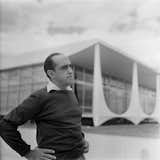Design Icon: 10 Buildings by Oscar Niemeyer
Brazil’s modern architectural visionary Oscar Niemeyer (1907-2012) imagined buildings with curvaceous, almost sensual forms that channeled his love of the female form. He famously wrote: "My work is not about ‘form follows function,’ but ‘form follows beauty’ or, even better, ‘form follows feminine.’" He also said he found inspiration in the curves in the mountains of his native country, as well as "in the sinuousness of its rivers, in the waves of the ocean"—the latter within eyesight of his main studio near Copacabana beach in Rio de Janeiro. Music is also a potent metaphor for Niemeyer’s pioneering work with concrete: it was said that the songs of bossa nova legend Tom Jobim were like a house built by Niemeyer.
Over the course of his legendary career, Niemeyer apprenticed and later collaborated with Brazilian architect and urban planner Lúcio Costa to develop the 196os planned city and capital of Brasília, sparred with Le Corbusier, whose work majorly influenced him, over the New York headquarters of the United Nations, and won the prestigious Pritzker Prize in 1988, just a few years after he returned to Brazil for the first time since he left for Paris in the mid-’60s due to the country’s military coup and his involvement with the Brazilian Communist Party.
Niemeyer brought his own grace and vision to the International Style, and did more than any other designer to bring the precepts of International Style to South America. He was considered the last of modernism’s "true believers," with a career that spanned seven decades and continued until the very end of his 104 years. Below, we highlight a few monumental designs from the Brazilian modernist’s expansive oeuvre.
Pampulha Architectural Complex (1943)
After starting his career by apprenticing then collaborating with Brazilian architect and urban planner Lúcio Costa, Oscar Niemeyer made his mark with the visionary garden city project in Belo Horizonte, Brazil. The highlight is the Church of St. Francis of Assisi, a revolutionary modernist touchstone with a parabolic roof and polychromatic tiles that was such an unexpected departure from previous chapel designs, one politician suggested demolishing it.
Brazilian National Congress (1964)
One of Niemeyer’s numerous contributions to Brasília, the planned city inaugurated as Brazil’s capital in the 1960s, was the National Congress building. Its design symbolizes the working of the legislative branch: two semicircles, one for the Congress and one for the Senate, are divided by twin office towers.
Ciccillo Matarazzo Pavilion (1957)
Niemeyer designed this three-story building, named after the Italian-Brazilian industrialist who founded the São Paulo Museum of Modern Art and the São Paulo Art Biennial (the latter hosted at this site), with Brazilian architect Hélio Uchôa. The modernist landmark’s interior gallery space features series of gently curving walkways.
Cathedral of Brasília (1970)
Niterói Contemporary Art Museum (1996)
Mondadori Headquarters (1975)
Niemeyer’s design for the headquarters of Arnoldo Mondadori Editore, one of Italy’s largest publishing companies, on the outskirts of Milan consists of a long, horizontal structure with a series of arches of varying lengths and sizes. The building, considered one of the architect’s most significant works in Europe, sits idyllically on a large lake.
JK Memorial (1980)
The Niemeyer-designed mausoleum and museum dedicated to Brazil’s 21st president and founder of Brasília Juscelino Kubitschek provides the late leader with a fitting resting place in the modern city he helped develop. A statue of the founder rests on a large, question mark–shaped sculpture atop the massive, white marble block in the nation’s capital.
Communist Party Headquarters (1972)
Sambadrome Marquês de Sapucaí (1983)
The Sambódromo is one of two works designed by Niemeyer once he returned to Brazil in the early ’80s after being exiled in the mid-’60s. The structure hosts the annual Rio Carnival parade and can hold 70,000 revelers. It includes the aptly titled Apotheosis Square, where bleachers are spaced out to create an open space for performances.
Oscar Niemeyer International Cultural Center (2011)
Aviles, Spain
This concrete-and-glass cultural center designed by and named after Niemeyer in Avilés, Spain (not to be confused with the Oscar Niemeyer Cultural Center in Goiás, Brazil) was built after the legendary Brazilian modernist hit the century mark. Subtle, bold flashes of color, and contrasting shapes create a cultural playground and gathering space.
Top photo by Gil Pinhero
This article was originally published on February 24, 2014. It was updated on December 12, 2024, to include current information.
Related Reading:
Published
Last Updated
Topics
Design NewsGet the Pro Newsletter
What’s new in the design world? Stay up to date with our essential dispatches for design professionals.










